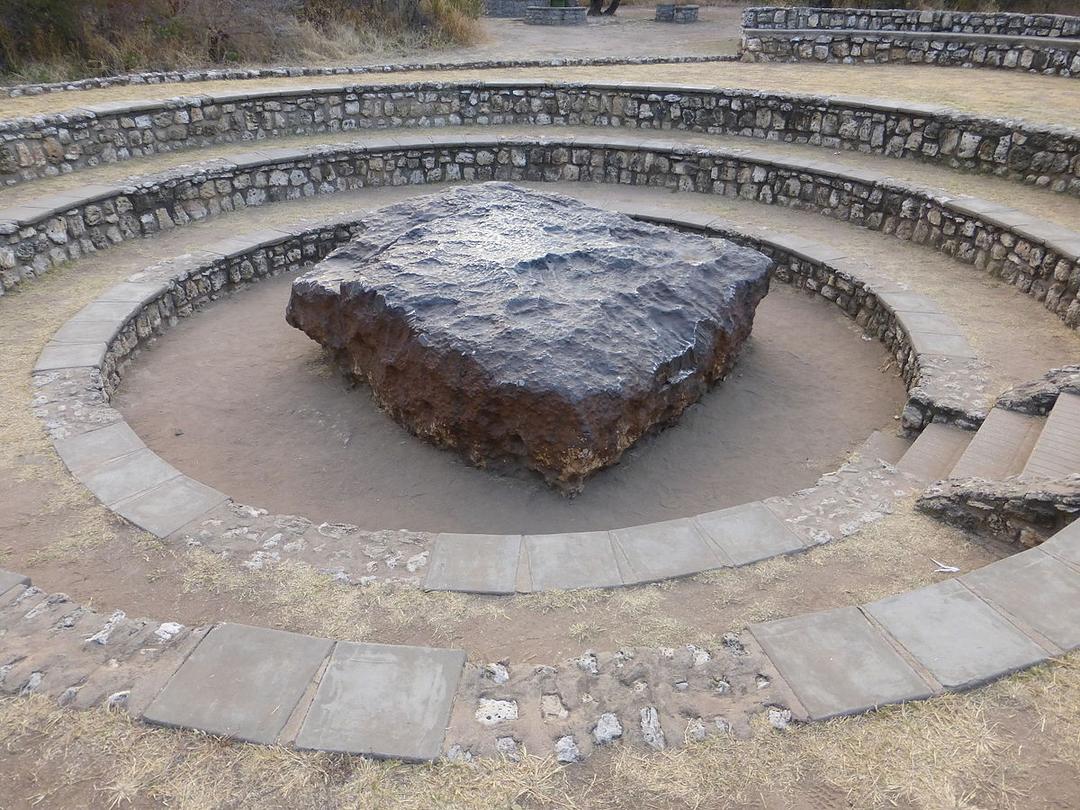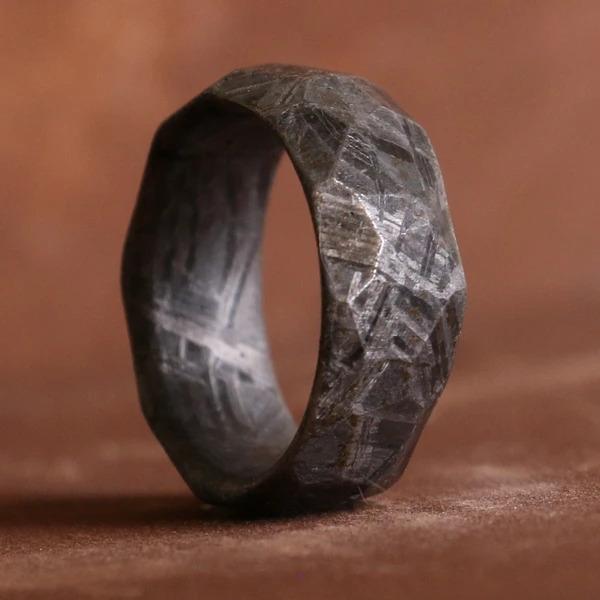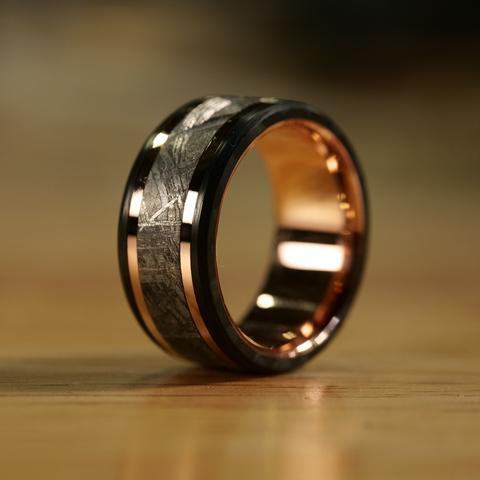Meteor vs Meteorite: All About Meteorite Rings

Meteor vs Meteorite: All About Meteorite Rings
What is a meteorite? Traveling through the depths of space, these rocky objects captivate our imaginations. They come from distant galaxies and have drifted for millions of years. By chance, these objects in space end up falling through our atmosphere. Bright meteors fly across the sky, leaving behind particles in orbit and breaking apart into stony meteorites. Coming down upon the planet as streaks of light and shooting stars, meteorites that make it down on our insignificant and minor planet seem like normal, unusual rocks. These celestial bodies are a rocky material that we love to use in our rings. A meteorite ring isn't just a piece of jewelry to our awesome customer base - it's a piece of the cosmos in the palm of your hand.
When people look at a genuine meteorite ring, the vast majority of people aren't thinking about the ring maker or vendor sourcing the material. You're thinking about the fact that these valuable space rocks travelled through the cosmos and survived their trip through our atmosphere. But have you ever wondered why they're valuable in the first place? Have you ever wondered if a meteorite ring is worth its price tag?
Meteorite jewelry is rare, valuable, and popular as engagement and wedding rings. We get inquiries all the time about ownership hassles and authenticity. But when it comes to questions about meteorites in general, there are a lot of misconceptions. There's a lot of confusion when it comes to defining Meteor vs Meteorite vs Meteoroids. A lot of people don't understand what a meteorite really is. We're here to settle the differences.
Meteor vs Meteorite
Lumps of rock and iron that enter the Earth's atmosphere quickly are called meteors. When a meteor falls through Earth's atmosphere during a meteor shower, it survives as an iron meteorite. These are the remains of meteorites that jewelers can use to make jewelry. The vast majority of meteors that plummet through our atmosphere don't make it upon impact. The majority of meteorites actually become tons of space dust that evaporate into beautiful trails that stretch for hundreds of kilometers across the sky.
Lumps of rock and iron that enter the Earth's atmosphere quickly are called meteors. When a meteor falls through Earth's atmosphere during a meteor shower, it survives as an iron meteorite. These are the remains of meteorites that jewelers can use to make jewelry. The vast majority of meteors that plummet through our atmosphere don't make it upon impact. The majority of meteorites actually become tons of space dust that evaporate into beautiful trails that stretch for hundreds of kilometers across the sky.
Meteorite vs Meteoroid vs Asteroid
Meteoroids are astral objects in interplanetary space that range in size from cosmic dust grains to large boulders. They're objects from asteroid belts or other distant galaxies. The difference between asteroids and meteoroids is that an asteroid tends to orbit around a star. Other meteoroids may slam into asteroid debris, causing pieces to break apart and fly into the void of space. These rocky bodies drift through space until they happen to plummet through the Earth's atmosphere.
Meteoroids are astral objects in interplanetary space that range in size from cosmic dust grains to large boulders. They're objects from asteroid belts or other distant galaxies. The difference between asteroids and meteoroids is that an asteroid tends to orbit around a star. Other meteoroids may slam into asteroid debris, causing pieces to break apart and fly into the void of space. These rocky bodies drift through space until they happen to plummet through the Earth's atmosphere.
Meteoroids are astral objects in interplanetary space that range in size from cosmic dust grains to large boulders. They're objects from asteroid belts or other distant galaxies. The difference between asteroids and meteoroids is that an asteroid tends to orbit around a star. Other meteoroids may slam into asteroid debris, causing pieces to break apart and fly into the void of space. These rocky bodies drift through space until they happen to plummet through the Earth's atmosphere.
What Does a Meteorite Look Like?
Meteorite is a grey metal made of mostly iron and nickel. Every meteorite has a unique crisscross pattern etched into its surface. These are from nickel-iron crystals that make up their Widmanstätten pattern. These patterns with their crystalline structure aren't something you can replicate or fake. Depending on the type of meteorite, the pattern's irregular shape can seem darker or lighter.
Meteorite is a grey metal made of mostly iron and nickel. Every meteorite has a unique crisscross pattern etched into its surface. These are from nickel-iron crystals that make up their Widmanstätten pattern. These patterns with their crystalline structure aren't something you can replicate or fake. Depending on the type of meteorite, the pattern's irregular shape can seem darker or lighter.
Common Types of Meteorites
Gibeon Meteorite
Gibeon meteorite contains a significant amount of common minerals like cobalt and phosphorus. The result is a larger number of darker areas in its crisscross pattern.
Seymchan Meteorite
This meteorite has a high amount of iridium and great rust resistance. Because of this, Seymchan slabs look lighter than other types of meteorite.
Muonionalusta Meteorite
The primary type we use is Muonionalusta meteorite. Real meteorite is ferromagnetic, expensive, and unique. You can't copy the pattern that each space rock will have. The crisscross pattern will always be consistent throughout a single slab. Knowing whether a meteorite ring is real is super easy because of this.
How Much is a Meteorite Worth?
The price varies substantially when it comes to the cost of a meteorite. Factors such as origin, composition, and weight are all important areas to consider for a meteorite's worth. The heavier the meteorite, the higher of a price you'll end up paying. The rarest types of meteorite on the market tend to be the most expensive.
For the ones that make it, extra duties and fees may arise depending on the location. If you're buying from an overseas vendor, you're going to have to pay additional fees. It doesn't help that a huge chunk of a meteorite's weight is gone by the time it lands. You probably think that's a good thing, but a smaller or damaged meteorite can make ring production difficult. This is why meteorite rings tend to be expensive because you can only use high quality meteorite slabs for rings.
A meteorite should ideally be large enough for a jeweler to work with. We've had excited customers in the past with space rock collections,only for them to discover that we can't use them to make meteorite jewelry. Unusual shapes make the cutting process difficult to make the most out of a meteorite.
The price varies substantially when it comes to the cost of a meteorite. Factors such as origin, composition, and weight are all important areas to consider for a meteorite's worth. The heavier the meteorite, the higher of a price you'll end up paying. The rarest types of meteorite on the market tend to be the most expensive.
For the ones that make it, extra duties and fees may arise depending on the location. If you're buying from an overseas vendor, you're going to have to pay additional fees. It doesn't help that a huge chunk of a meteorite's weight is gone by the time it lands. You probably think that's a good thing, but a smaller or damaged meteorite can make ring production difficult. This is why meteorite rings tend to be expensive because you can only use high quality meteorite slabs for rings.
A meteorite should ideally be large enough for a jeweler to work with. We've had excited customers in the past with space rock collections,only for them to discover that we can't use them to make meteorite jewelry. Unusual shapes make the cutting process difficult to make the most out of a meteorite.
Do Meteorite Rings Rust?
Rust is a common issue since meteoritic material is made from mainly iron. But you can reduce the chance of rust forming by keeping it away from common rust causing issues. Contact with water is something you have to avoid. Keeping the iron in meteorites away from moisture and preventing physical damage to its surface can extend the life of your meteorite ring.
All of our meteorite rings have a protective layer coating, but frequent washing and scrubbing can lead to issues down the road. Keeping your meteorite ring clean can make your ring last a lifetime. If you utilize WD-40 and a soft cloth, you can wipe away any existing rust. Once done, you can use a thin layer of ring wax to recoat the ring to help repel and prevent rust.
You might need extra care compared to a cheaper band like titanium. But you're not dealing with an ordinary band. You're handling a unique and valuable piece of outer space.
Meteorite Engagement Rings
Like the rest of our rings, every meteorite ring is unique and one-of-a-kind. We have a massive collection of women and men's meteorite rings.
Our standard Meteorite Ring is one of our most popular rings. The ring's sharp beveled edges pair beautifully with any chosen liner.
Another popular and affordable meteorite ring is our Obsidian Meteorite Ring. While it's the same type of meteorite as our standard Meteorite Ring, there's one key difference that a lot of people like. The obsidian facets create an edgy yet attractive pattern. It's a fiercer version of our normal Meteorite Ring.
The wonderful thing about meteorite is that you can also add it to other metal bands, especially to help deal with rust. If you’d like something with more detail, our Meteorite and Carbon Fiber Ring with Rose Gold Liner is a fantastic option. It’s a beautiful multi-piece ring of carbon fiber, gold, and meteorite. The etched meteorite inlay's natural pattern looks much more pronounced. But you don't have to stick with the default parts. We can swap out the 10 karat gold liner for rose, yellow, or white gold. Regardless of what you choose, your piece of meteorite's crystalline pattern will always be unique.
Get a Ring as Stellar As You
From the above options, you probably realize that you can have all sorts of variations for your wedding or engagement ring. You might want to explore all the additional customization options before you settle on a single ring. But out of all our available options, one thing is certain for all of them: Every one of our authentic meteorite rings has a story behind their journey through space.
Each slab we work with comes from a meteoroid that travelled from a faraway galaxy. The meteoroid came from fragments of distant asteroids in space. You'll never know when or where the cosmic event happened. These original asteroids could have been thousands of miles in diameter, so other objects in space going at millions of miles per hour. Now, after traveling millions of light years, a piece of the cosmos is in the palm of your hand.
You can always settle with a traditional metal band. You have a nearly infinite range of styles to choose from. Sterling silver, gold, or a tungsten wedding band are all viable options. But these metals are boring and lack a story. They didn't come from a distant galaxy as heated meteorite. Compared to traditional rings, meteorite bands will always remain one of the most valuable alternative metals you can pick. You'll find a truly unique story in each and every meteorite ring. Find your story today.






























